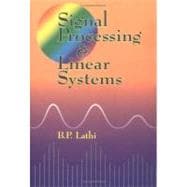
Note: Supplemental materials are not guaranteed with Rental or Used book purchases.
Purchase Benefits
What is included with this book?
| Background | |
| Complex Numbers | |
| Sinusoids | |
| Sketching Signals | |
| Cramer''s Rule | |
| Partial Fraction Expansion | |
| Vectors and Matrices | |
| Miscellaneous | |
| Introduction to Signals and Systems | |
| Size of a Signal | |
| Classification of Signals | |
| Some Useful Signal Operations | |
| Some Useful Signal Models | |
| Even and Odd Functions | |
| Systems | |
| Classification of Systems | |
| System Model: Input-Output Description | |
| Time-Domain Analysis of Continuous-Time Systems | |
| Introduction | |
| System Response to Internal Conditions: Zero-Input Response | |
| The Unit Impulse Response h(t) | |
| System Response to External Input: Zero-State Response | |
| Classical Solution of Differential Equations | |
| System Stability | |
| Intuitive Insights into System Behavior | |
| Appendix 2.1: Determining the Impulse Response | |
| Signal Representation by Fourier Series | |
| Signals and Vectors | |
| Signal Comparison: Correlation | |
| Signal Representation by Orthogonal Signal Set | |
| Trigonometric Fourier Series | |
| Exponential Fourier Series | |
| Numerical Computation of Dn | |
| LTIC System response to Periodic Inputs | |
| Appendix | |
| Continuous-Time Signal Analysis: The Fourier Transform | |
| Aperiodic Signal Representation by Fourier Integral | |
| Transform of Some Useful Functions | |
| Some Properties of the Fourier Transform | |
| Signal Transmission through LTIC Systems | |
| Ideal and Practical Filters | |
| Signal Energy | |
| Application to Communications: Amplitude Modulation | |
| Angle Modulation | |
| Data Truncation: Window Functions | |
| Sampling | |
| The Sampling Theorem | |
| Numerical Computation of Fourier Transform: The Discrete Fourier Transform(DFT) | |
| The Fast Fourier Transform (FFT) | |
| Appendix 5.1 | |
| Continuous-Time System Analysis Using the Laplace Transform | |
| The Laplace Transform | |
| Some Properties of the Laplace Transform | |
| Solution of Differential and Integro-Differential Equations | |
| Analysis of Electrical Networks: The Transformed Network | |
| Block Diagrams | |
| System Realization | |
| Application to Feedback and Controls | |
| The Bilateral Laplace Transform | |
| Appendix 6.1: Second Canonical Realization | |
| Frequency Response and Analog Filters | |
| Frequency Response of an LTIC System | |
| Bode Plots | |
| Control System Design Using Frequency Response | |
| Filter Design by Placement of Poles and Zeros of H(s) | |
| Butterworth Filters | |
| Chebyshev Filters | |
| Frequency Transformations | |
| Filters to Satisfy Distortionless Transmission Conditions | |
| Discrete-Time Signals and Systems | |
| Introduction | |
| Some Useful Discrete-Time Signal Models | |
| Sampling Continuous-Time Sinusoids and Aliasing | |
| Useful Signal Operations | |
| Examples of Discrete-Time Systems | |
| Time-Domain Analysis of Discrete-Time Systems | |
| Discrete-Time System Equations | |
| System Response to Internal Conditions: Zero-Input Response | |
| Unit Impulse Response h[k] | |
| System Response to External Input: Zero-State Response | |
| Classical Solution of Linear Difference Equations | |
| System Stability | |
| Appendix 9.1: Determining Impulse Response | |
| Fourier Analysis of Discrete-Time Signals | |
| Periodic Signal Representation by Discrete-Time Fourier Series | |
| Aperiodic Signal Representation by Fourier Integral | |
| Properties of DTFT | |
| DTFT Connection with the Continuous-Time Fourier Transform | |
| Discrete-Time Linear System Analysis by DTFT | |
| Signal Processing Using DFT and FFT | |
| Generalization of DTFT to the Z-Transform | |
| Discrete-Time System Analysis Using the Z-Transform | |
| The Z-Transform | |
| Some Properties of the Z-Transform | |
| Z-Transform Solution of Linear Difference Equations | |
| System Realization | |
| Connection Between the Laplace and the Z-Transform | |
| Sampled-Data (Hybrid) Systems | |
| The Bilateral Z-Transform | |
| Frequency Response and Digital Filters | |
| Frequency Response of Discrete-Time Systems | |
| Frequency Response From Pole-Zero Location | |
| Digi | |
| Table of Contents provided by Publisher. All Rights Reserved. |
The New copy of this book will include any supplemental materials advertised. Please check the title of the book to determine if it should include any access cards, study guides, lab manuals, CDs, etc.
The Used, Rental and eBook copies of this book are not guaranteed to include any supplemental materials. Typically, only the book itself is included. This is true even if the title states it includes any access cards, study guides, lab manuals, CDs, etc.